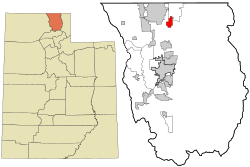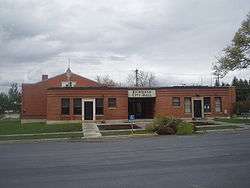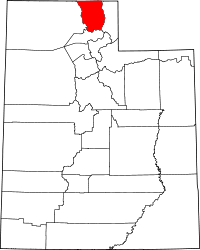Richmond, Utah
| Richmond, Utah | |
|---|---|
| City | |
|
Richmond City Hall | |
 Location in Cache County and the state of Utah. | |
| Coordinates: 41°55′10″N 111°48′37″W / 41.91944°N 111.81028°WCoordinates: 41°55′10″N 111°48′37″W / 41.91944°N 111.81028°W | |
| Country | United States |
| State | Utah |
| County | Cache |
| Settled | 1859 |
| Area | |
| • Total | 3.4 sq mi (8.9 km2) |
| • Land | 3.4 sq mi (8.9 km2) |
| • Water | 0.0 sq mi (0.0 km2) |
| Elevation[1] | 4,610 ft (1,405 m) |
| Population (2010) | |
| • Total | 2,470 |
| • Density | 716/sq mi (276.5/km2) |
| Time zone | Mountain (MST) (UTC-7) |
| • Summer (DST) | MDT (UTC-6) |
| ZIP code | 84333 |
| Area code(s) | 435 |
| FIPS code | 49-63680[2] |
| GNIS feature ID | 1444892[1] |
| Website |
richmond-utah |
Richmond is a city in Cache County, Utah, United States. The population was 2,470 at the 2010 census,[3] with an estimated population of 2,535 in 2014.[4] It is included in the Logan, Utah-Idaho Metropolitan Statistical Area.
History
Agrippa Cooper was the first settler in Richmond in the mid-1850s. Within a few years a scattering of log cabins, dugouts, and a log fort had been built. In 1860, a sawmill and a schoolhouse were erected.[5][6] The city was likely named in honor of LDS apostle Charles C. Rich, though it may also have been named for the rich local soil or for Richmond, London, the hometown of some of its English settlers.[6]
Richmond was incorporated in 1868.[7]
Holstein cows were brought to Richmond in 1904, and thrived so well that the town was recognized as Utah's Holstein center. In 1912, the Richmond Holstein Cow Show was the first in the county. Now called Richmond's "Black & White Days", the show continues into its 98th year, and features carnival rides, food vendors, and a horse pull parade.[5][8]
The town's first two creameries—Cache Valley Dairy and Union Creamery—each produced up to 40,000 pounds of milk per day in 1902. The creameries were absorbed by Utah Condensed Milk Company in 1904, and then reorganized as Sego Milk Products in 1920.[5] For many years, the plant was the largest operation west of the Mississippi.
In 1971, Richmond resident Arthur Morin and 11 of his children drove 2,700 miles (4,300 km) in a camper to Lehigh Acres, Florida, to compete as finalists in the All American Family competition.[9]
Part of the film Napoleon Dynamite was filmed in Richmond.
The hillside letters "NC" (for "North Cache") are visible on a mountainside east of Richmond at 41°55′27″N 111°47′12″W / 41.9243°N 111.7867°W
Geography
According to the United States Census Bureau, the city has a total area of 3.4 square miles (8.9 km2), all of it land.[3]
Richmond is located in the Cache Valley.
Climate
This climatic region is typified by large seasonal temperature differences, with warm to hot (and often humid) summers and cold (sometimes severely cold) winters. According to the Köppen Climate Classification system, Richmond has a humid continental climate, abbreviated "Dfb" on climate maps.[10]
Demographics
| Historical population | |||
|---|---|---|---|
| Census | Pop. | %± | |
| 1870 | 817 | — | |
| 1880 | 1,198 | 46.6% | |
| 1890 | 1,232 | 2.8% | |
| 1900 | 1,111 | −9.8% | |
| 1910 | 1,562 | 40.6% | |
| 1920 | 1,396 | −10.6% | |
| 1930 | 1,140 | −18.3% | |
| 1940 | 1,131 | −0.8% | |
| 1950 | 1,091 | −3.5% | |
| 1960 | 977 | −10.4% | |
| 1970 | 1,000 | 2.4% | |
| 1980 | 1,705 | 70.5% | |
| 1990 | 1,955 | 14.7% | |
| 2000 | 2,051 | 4.9% | |
| 2010 | 2,470 | 20.4% | |
| Est. 2015 | 2,580 | [11] | 4.5% |
| [4] | |||
As of the census[2] of 2000, there were 2,051 people, 619 households, and 526 families residing in the city. The population density was 696.1 people per square mile (268.4/km²). There were 654 housing units at an average density of 222.0 per square mile (85.6/km²). The racial makeup of the city was 97.32% White, 0.20% African American, 0.15% Native American, 0.20% Asian, 1.56% from other races, and 0.59% from two or more races. Hispanic or Latino of any race were 2.49% of the population.
There were 619 households out of which 49.9% had children under the age of 18 living with them, 73.5% were married couples living together, 8.1% had a female householder with no husband present, and 14.9% were non-families. 13.7% of all households were made up of individuals and 6.9% had someone living alone who was 65 years of age or older. The average household size was 3.31 and the average family size was 3.68.
In the city the population was spread out with 37.3% under the age of 18, 9.9% from 18 to 24, 25.5% from 25 to 44, 19.2% from 45 to 64, and 8.1% who were 65 years of age or older. The median age was 27 years. For every 100 females there were 98.2 males. For every 100 females age 18 and over, there were 98.5 males.
The median income for a household in the city was $42,138, and the median income for a family was $45,500. Males had a median income of $31,743 versus $21,778 for females. The per capita income for the city was $14,312. About 5.8% of families and 6.7% of the population were below the poverty line, including 6.8% of those under age 18 and 7.7% of those age 65 or over.

Economy
Goldfish crackers are produced at a Pepperidge Farm facility in Richmond. In 2011, the plant was producing over 1 million cases of Goldfish annually.[12]
The Richmond city website links to several local businesses, including Rockhill Creamery, and My Favorite Gun Store.[13]
Parks and recreation
Mount Naomi Wilderness, within the Wasatch-Cache National Forest, is located east of Richmond.
Education
All 8th and 9th grade students in the north end of Cache School District attend North Cache 8-9 Center, and advance to Sky View High School.
Notable people
- Herschel Bullen, businessman, politician and leader in The Church of Jesus Christ of Latter-day Saints
- Paula Hawkins, U.S. senator from Florida; attended high school in Richmond
- William Jasper Kerr, chancellor of Oregon University System and president of Oregon State University, Brigham Young College, and Utah State Agricultural College
- Israel Keyes, serial killer
- Malcolm H. Merrill, director of California Department of Public Health, and recipient of 1976 Sedgwick Memorial Medal[14]
- Marriner W. Merrill and son Joseph F. Merrill, both members of the Quorum of the Twelve Apostles of The Church of Jesus Christ of Latter-day Saints
- Thomas Levi Whittle, Mormon pioneer and early settler of Richmond
See also
References
- 1 2 U.S. Geological Survey Geographic Names Information System: Richmond
- 1 2 "American FactFinder". United States Census Bureau. Archived from the original on September 11, 2013. Retrieved 2008-01-31.
- 1 2 "Geographic Identifiers: 2010 Census Summary File 1 (G001): Richmond city, Utah". U.S. Census Bureau, American Factfinder. Retrieved August 7, 2015.
- 1 2 "Annual Estimates of the Resident Population: April 1, 2010 to July 1, 2014 (PEPANNRES): Incorporated Places in Utah". U.S. Census Bureau, American Factfinder. Retrieved August 7, 2015.
- 1 2 3 Utah: A Guide to the State. Utah State Institute of Fine Arts. 1941.
- 1 2 Cheri Housley; Marie Lundgreen & Kathy Jones (2011). Richmond. Arcadia.
- ↑ Laws of the Territory of Utah Passed at the Twenty-Sixth Session of the Legislative Assembly. Tribune. 1884.
- ↑ "Black & White Days". Richmond City.
- ↑ "Utah Family of 13 Vying for Title". Sarasota Herald-Tribune. Aug 13, 1971.
- ↑ Climate Summary for Richmond, Utah
- ↑ "Annual Estimates of the Resident Population for Incorporated Places: April 1, 2010 to July 1, 2015". Retrieved July 2, 2016.
- ↑ "Here is the latest Utah news from The Associated Press". NECN.COM. Nov 14, 2011.
- ↑ "Richmond Businesses". Richmond City.
- ↑ "Berkeley Doctor to Survey Russian Health Facilities". Deseret News. Aug 10, 1957.
External links
 |
Lewiston | |
Wasatch-Cache National Forest / |
 |
| Trenton | |
Wasatch-Cache National Forest / Garden City | ||
| ||||
| | ||||
| Amalga | Smithfield | Wasatch-Cache National Forest / Laketown |

